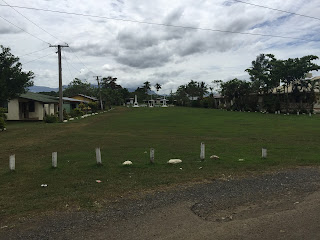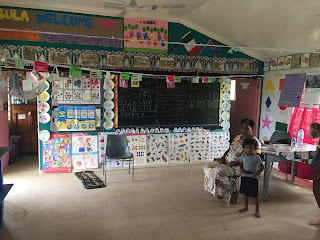This has not been a very full day. We didn’t begin until 9 a.m., and we essentially finished at noon. The rest of the time has been free for sitting by the pool, etc. It is plenty hot for other activities, and more rain appears to be on the way for afternoon.
Our morning was spent at a local village. On the way, we were briefed on all of the protocols for meeting the village chief, but he was a no-show. In fact, no men met with us at all. The wife of the village head man (second to the chief) was our hostess, along with several other older women. It appeared that almost everyone younger was away working somewhere, either in the fields or in town.
The first order of business was an official Kava (KAH-vah) ceremony. We stood outside the main door of the village hall, removed our shoes, and all together shouted the Fijian equivalent of, “may we come in?” When answered by the same women who had greeting us when we got off the bus (but who had entered the hall by a side door) we entered and sat of woven mats on the floor.
Our guide provided our gift of two small bags of Kava power. Kava is a plant that grows wild in the hills, but now is cultivated for local consumption. It looks similar to sugarcane, but it it primarily the root that is dried and ground into powder. The powder is poured into a cloth, soaked in water, and then wrung out into a large bowl. It has the consistency of dishwater, and a flavor that resembles dishwater, as well. It is definitely an acquired taste.
The Kava drink is scooped out of the large bowl with a half coconut shell and presented to the “chief” of our group. On the bus, we had designated a retired oil company executive from Alaska as our chief for the day. “Chief Bruce” was asked if he wanted “high tide” (a full bowl) or “low tide” (just a taste). Being adventurous, he took high tide. The same bowl was refilled and presented to each of us in turn, common cup.
Each person receives the bowl by shouting “Bula!” (BOO-lah) — an all-pupose word that means “hello,” “welcome,” “cheers” or what you say in Fiji whenever you don’t know what else to say. Then you empty the cup in one chug while everyone in the circle claps three times. Handing the bowl back to the cup-bearer, the drinker shouts “Ven-EE-kah,” which means “thank you.” When everyone present has had their drink, seconds are offered.
No one in our group took seconds, but everyone took at least low tide. We’re an adventurous group. We had been told that we could pass, but for a native Fijian it would be a big insult to turn down at least one bowl of Kava.
Kava is not alcoholic, but has a mild sedative or anesthetic quality. Even a small drink leaves a bit of numbness of the tongue. Large quantities lead to slurred speech and sleepiness. It is the stuff that makes peace among warring tribes.
After Kava we had a very leisurely, somewhat haphazard tour of the village, which consists of 52 houses and a couple hundred people. We visited the pre-school, which is still out for summer vacation, but will start again next week. The teacher happened to be there, preparing the room. She walks from another village and stays through the week, returning home on weekends. This school is free for all children, ages 3-5.
Primary school students walk to school in a nearby village, and high school students ride a city bus to a place a bit farther away. All education for ages 3-18 is free, as is health care for all. The village has a “nurse,” who was described as more of a person trained in first aid. A clinic is in a nearby town, and a hospital in a city about a half-hour drive away. This is not a wealthy country, but they afford this, which make one wonder why the U.S. finds it so difficult.
We were also shown the “Fijian Phone Booth” where the log drum is housed. The drum is only sounded by the Head Man, who calls the villagers to weekly town meetings, to the Methodist church on Sunday, and to alert in times of danger. As she was showing us this traditional medium of communication, her cell phone rang, with her son calling via Facetime from Canada. So much for the Fijian Phone Booth.
Our tour ended with lunch back at the village hall. The meal consisted of fish, fresh water muscles, taro, plantains, egg plant, spinich, and pineapple, along with fruit juice. Fijian food tends to be pretty bland, so many of the restaurants serve a “Findian” menu, adding Indian curries and spices to traditional dishes.
When we were finished, the women sang a traditional farewell song, with several parts of harmony. It was similar to the song that the boat crew sang to us yesterday as the boat docked at the end of the day. It seems to be a song that every Fijian knows well.
Our morning was spent at a local village. On the way, we were briefed on all of the protocols for meeting the village chief, but he was a no-show. In fact, no men met with us at all. The wife of the village head man (second to the chief) was our hostess, along with several other older women. It appeared that almost everyone younger was away working somewhere, either in the fields or in town.
The first order of business was an official Kava (KAH-vah) ceremony. We stood outside the main door of the village hall, removed our shoes, and all together shouted the Fijian equivalent of, “may we come in?” When answered by the same women who had greeting us when we got off the bus (but who had entered the hall by a side door) we entered and sat of woven mats on the floor.
Our guide provided our gift of two small bags of Kava power. Kava is a plant that grows wild in the hills, but now is cultivated for local consumption. It looks similar to sugarcane, but it it primarily the root that is dried and ground into powder. The powder is poured into a cloth, soaked in water, and then wrung out into a large bowl. It has the consistency of dishwater, and a flavor that resembles dishwater, as well. It is definitely an acquired taste.
The Kava drink is scooped out of the large bowl with a half coconut shell and presented to the “chief” of our group. On the bus, we had designated a retired oil company executive from Alaska as our chief for the day. “Chief Bruce” was asked if he wanted “high tide” (a full bowl) or “low tide” (just a taste). Being adventurous, he took high tide. The same bowl was refilled and presented to each of us in turn, common cup.
Each person receives the bowl by shouting “Bula!” (BOO-lah) — an all-pupose word that means “hello,” “welcome,” “cheers” or what you say in Fiji whenever you don’t know what else to say. Then you empty the cup in one chug while everyone in the circle claps three times. Handing the bowl back to the cup-bearer, the drinker shouts “Ven-EE-kah,” which means “thank you.” When everyone present has had their drink, seconds are offered.
No one in our group took seconds, but everyone took at least low tide. We’re an adventurous group. We had been told that we could pass, but for a native Fijian it would be a big insult to turn down at least one bowl of Kava.
Kava is not alcoholic, but has a mild sedative or anesthetic quality. Even a small drink leaves a bit of numbness of the tongue. Large quantities lead to slurred speech and sleepiness. It is the stuff that makes peace among warring tribes.
After Kava we had a very leisurely, somewhat haphazard tour of the village, which consists of 52 houses and a couple hundred people. We visited the pre-school, which is still out for summer vacation, but will start again next week. The teacher happened to be there, preparing the room. She walks from another village and stays through the week, returning home on weekends. This school is free for all children, ages 3-5.
Primary school students walk to school in a nearby village, and high school students ride a city bus to a place a bit farther away. All education for ages 3-18 is free, as is health care for all. The village has a “nurse,” who was described as more of a person trained in first aid. A clinic is in a nearby town, and a hospital in a city about a half-hour drive away. This is not a wealthy country, but they afford this, which make one wonder why the U.S. finds it so difficult.
 |
| Methodist Church |
Our tour ended with lunch back at the village hall. The meal consisted of fish, fresh water muscles, taro, plantains, egg plant, spinich, and pineapple, along with fruit juice. Fijian food tends to be pretty bland, so many of the restaurants serve a “Findian” menu, adding Indian curries and spices to traditional dishes.
When we were finished, the women sang a traditional farewell song, with several parts of harmony. It was similar to the song that the boat crew sang to us yesterday as the boat docked at the end of the day. It seems to be a song that every Fijian knows well.







No comments:
Post a Comment